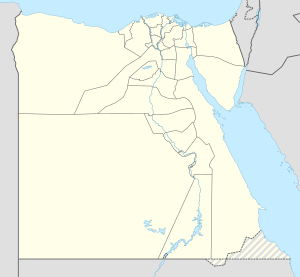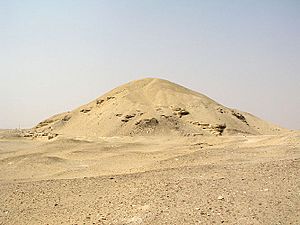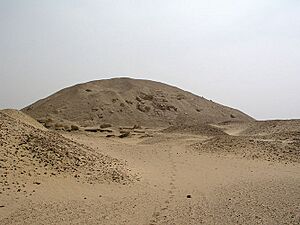Lisht facts for kids
Quick facts for kids
Lisht
|
|
|---|---|
| Country | |
| Governorate | Giza Governorate |
| Time zone | UTC+2 (EST) |
| • Summer (DST) | +3 |
Lisht or el-Lisht (Arabic: اللشت, romanized: Al-Lišt) is an Egyptian village located south of Cairo. It is a very important ancient site. Here, kings and important people from the Middle Kingdom were buried.
Two large pyramids were built here by kings Amenemhat I and Senusret I. These main pyramids were surrounded by smaller pyramids for royal family members. Many mastaba tombs (flat-topped tombs) were also built for high officials and their families. These tombs were built during the Twelfth and Thirteenth Dynasties.
Lisht is also famous for the tomb of Senebtisi. Her tomb was found untouched, and amazing jewelry was discovered inside. The pyramid complex of Senusret I is the best preserved from this time. Also, the coffins in the tomb of Sesenebnef have the earliest known writings from the Book of the Dead.
Contents
What is Lisht?
The ancient Egyptian site of el-Lisht is on the west side of the Nile River. It is about 65 kilometers (40 miles) south of Cairo. This area was a burial ground (necropolis) during the Twelfth Dynasty. It is near the ancient city of Itj-Tawy, which the modern village might be named after.
The capital city of Egypt during the Eleventh Dynasty was Thebes. But the first king of the Twelfth Dynasty, Amenemhet I, moved the capital. He moved it from Thebes to a new city near el-Lisht called Itj-tawy. This new location was good for controlling both Upper and Lower Egypt. It was also close to the Fayyum region, which was good for farming.
The exact ruins of Itj-Tawy have not been found yet. Only pieces of pottery have been discovered where it is believed to be. However, the pyramids built by the Twelfth Dynasty rulers at el-Lisht are well known to researchers.
El-Lisht served as the burial place for the first two rulers of Dynasty XII: Amenemhet I and his son, Senusret I. Their pyramids would have been seen by people traveling to Itj-Tawy from the south. Amenemhat I's pyramid complex had a special hall for offerings. It featured a granite altar carved with pictures of people from different regions bringing gifts to the pharaoh. Sadly, this pyramid is now mostly ruined. It stands only about 20 meters (65 feet) above the ground.
Lisht is also interesting because its builders used stones from older monuments. This was like "recycling" ancient stones. Some people think this showed a desire to bring back the glory of Egypt's Old Kingdom. The style of carvings also changed during the Twelfth Dynasty, and you can see this in the two pyramids at Lisht.
Who Explored Lisht?
El-Lisht was first explored in 1882 by a French Egyptologist named Gaston Maspero. He was from Paris but loved Egyptian history. He later became the head of archaeological work in Egypt.
Maspero founded the French Institute for Oriental Archaeology. This group continued to dig at Lisht from 1884 to 1885. Later, from 1906 to 1934, the Egyptian Expedition from the Metropolitan Museum of Art in New York worked there. They excavated for fourteen seasons. The Metropolitan Museum of Art returned to Lisht again between 1984 and 1991.
The Pyramid of Amenemhet I (North Side)
The Pyramid of Amenemhet I was originally about 55 meters (180 feet) tall. But because it was not built very well, and due to stone quarrying and tomb robberies, it is now only about 20 meters (65 feet) high. The materials used were not very strong. It was made from unfired mudbricks and stones taken from other monuments. Mudbricks, sand, and debris were cheap and easy to find.
Archaeologists found stones from the monuments of other kings like Khufu, Khafre, Unas, and Pepy. These stones were reused in Amenemhat's pyramid complex.
Later digs showed that the original plan for the pyramid was much bigger. One idea is that the ground was not stable enough for a larger building. Another idea is that the pharaoh was getting old and sick. He might have wanted his tomb finished quickly, even if it meant making it smaller. A third idea is that Amenemhat I died after designing the tomb. His son, Senusret I, then quickly finished his father's burial place so he could start building his own.
The pyramid's real entrance is on its north side. A hallway made of pink granite leads to a small room inside the pyramid. From there, a shaft goes down to the burial chamber. This chamber has been filled with water from the Nile River over the years. This makes it hard to discover new things. Pumping out the water has not worked well. No complete statues of Amenemhat I were found. However, a limestone head, believed to be from a statue of the pharaoh, was discovered.
- Other important tombs found near Amenemhet I's pyramid
- Tomb 384 of Rehuerdjersen
- Tomb 400 of Intefiqer
- Tomb 470 of Senimeru
- Tomb 493 of Nakht
- Tomb 758 of Senusret, which had the undisturbed tomb of Senebtisi
- Tomb 954
- Tomb 956
- Pit 412, where stone slabs (stelae) mentioning King's son Hepu and Queen Abetni were found.
The Pyramid of Senusret I (South Side)
Senusret I built his pyramid on the south side of el-Lisht. It is about a mile south of his father's tomb complex. This pyramid was called 'Senusret Looks Down on Both Lands'. Gaston Maspero also discovered it in 1882. He knew who owned it because objects inside had the pharaoh's name.
The excavation team found carved blocks, fragments, and small shrines. These matched the art style of the Middle Kingdom. Later, in 1894, archaeologists J.E. Gautier and G. Jequier worked there until 1895. From 1906 to 1943, a team from the Metropolitan Museum of Art excavated it. Then, from 1984 to 1987, Dieter Arnold led more excavations.
Senusret I's pyramid was much larger than his father's. Its base was 105 meters (344 feet) wide, and it was once 61.25 meters (200 feet) tall. Senusret followed a similar plan to his father's. However, his architects used a new building method to make the pyramid stronger. They built it outwards from a core of rough limestone blocks. This core was filled with mudbrick and debris. Then, they covered the central structure with heavy blocks and a smooth outer layer of white limestone. This building method was used for much of the Middle Kingdom.
A causeway (a raised road) led to the pyramid. It had spaces along the sides where large limestone statues of Senusret I stood. Some of these statues are now in the Metropolitan Museum of Art in New York and the Museum of Egyptian Antiquities in Cairo. Mudbrick buildings for priests were also along the causeway. These priests would perform rituals for the dead king.
On the north side of the pyramid was a small chapel. It had an alabaster false door stela (a carved stone slab). This stela was decorated with pictures of offerings being presented. The funerary temple was to the east, at the start of the causeway. Its style was similar to that of Pepi II, a king from the Sixth Dynasty. Inside the pyramid, a central passage led to the burial chamber. This chamber had sculpted lion heads that would spout water into a drain.
While some of the inner structure of Senusret's pyramid is still there, the pyramid itself is mostly rubble. The burial chamber is flooded with water from the Nile. Many of the pyramid's treasures were stolen long ago. It seems the tomb was robbed soon after it was sealed. Besides the main tomb passage, another tunnel was found. This tunnel was used to bring burial items to the chambers. Maspero thought this tunnel was used by thieves to rob the pyramid. This is because funerary goods from the king’s chambers were found there.
- Other important tombs found near Senusret I's pyramid
- Tomb of Senewosret-Ankh
- Tomb of a certain Senusret, with the untouched shaft of Hapy
- Tomb of Intef (?)
- French tomb
- Tomb of Imhotep
- Tomb of Mentuhotep
- Tomb, South-Khor A
- Tomb, South-Khor B
- Tomb A in South area
- Tomb of Djehuty
- Tomb of Ipi
- Tomb D in South area
- Tomb E in South area
- Tomb of Sehetepibreankh
Funerary Temples at Lisht
Both Amenemhet I and Senusret I had special temples for their burials. We know more about Senusret's temple because his father's is almost completely destroyed. Only carvings of the Nile god and local gods remain from Amenemhet I's temple. It is believed that Senusret rebuilt Amenemhet's temple because Senusret's name is on the temple's foundations.
Since more of Senusret I's temple remains, it was easier to figure out its original design. We know it was similar to temples from Dynasty VI. It had a courtyard, a covered walkway (portico), and an offering hall with storage rooms on both sides.
Over time, the tombs of wives, children, and close officials were built around these kings' temples. It became a large area filled with graves for their families and servants. After the dynasty ended, people no longer guarded the burial ground. This allowed grave robbers and looters to steal from the tombs.
See also
- List of ancient Egyptian sites, including sites of temples
- List of Egyptian pyramids
- List of megalithic sites




